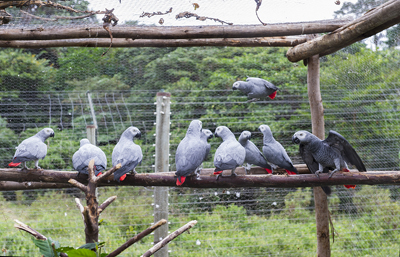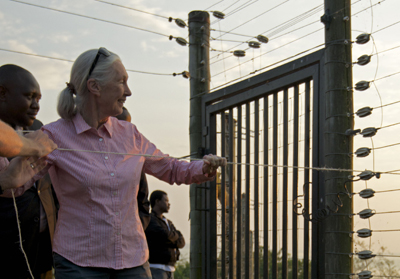An end to the trade in wild-caught African Grey parrots has come one step closer to reality. A number of African countries (including Gabon, Angola, Chad, Guinea, Nigeria, Senegal and Togo) together with the European Union and United States have submitted a proposal to transfer Grey and Timneh parrots to CITES Appendix 1. If accepted, it will halt all international trade in wild Greys, saving tens of thousands of wild birds each year.
It may surprise many to learn that a legal trade in wild caught Grey parrots is still permitted under the Convention on International Trade in Endangered Species of Fauna and Flora known as CITES. Over the last 40 years, over 1.3 million African Greys have been exported. Taking into account those that die before export, and illegal and unreported trade the true number of parrots taken from the wild is much higher. This is unsustainable.
_(c)_TL2:Lukuru_Project.jpg)
Photo: African Grey Parrots drawn to trap site. Photo by Andrew Barnard
Recent studies show declines of 90-99% over the last two decades in Ghana and there is little evidence that declines are less severe elsewhere in West Africa. In the Congo Basin, where the largest populations occur, rapid increases in trapping have been recorded in recent years. Trappers report moving into increasingly remote areas of the Democratic Republic of Congo (DRC) following declines in the elsewhere of the country. The DRC exports thousands of Grey parrots each year, often far in excess of CITES quotas. See: http://www.birdlife.org/africa/news/ghana’s-grey-parrot-population-may-soon-cease-exist.
Also, see: https://journals.cambridge.org/action/displayAbstract?fromPage=online&aid=10083443&fileId=S0030605315001234.
_(c)_TL2:Lukuru_Project.jpg)
Trapped African Grey Parrots, crated for export. Photo by: Lukuru Foundation
Next month, the decision-makers at CITES will consider a proposal to transfer Grey and Timneh parrots to CITES Appendix 1. Under the leadership of the World Parrot Trust, we are asking the public to weigh in by signing a petition in support of the up-listing. See here: https://www.change.org/p/tell-cites-to-end-trade-in-african-grey-parrots-savegreys
In just a few days, over 40,000 people have signed the petition. My deepest thanks to those of you that have already signed, and a sincere invitation to those who have not to please consider. The fate of one of nature’s most intelligent and beautiful parrots may hang in the balance.
Over three years ago, 17 Grey parrots were released on Ngamba Island, in Lake Victoria, Uganda. These parrots were the sole survivors of an original group of 108 wild Grey parrots that were likely trapped in the Democratic Republic of the Congo, and later confiscated by authorities as they were being smuggled into Bulgaria.

The pre-release aviary holding 17 Grey parrots. Photo by Dr. Rowan Martin.
The 108 birds were housed temporarily in the Sophia Zoo in Bulgaria, while the World Parrot Trust sought a suitable release site for the birds, and secured the various bureaucratic permissions required for release.
Following quarantine, rehabilitation, and health checks, the 17 surviving birds were released from the Ngamba Island Wildlife Sanctuary by Dr. Jane Goodall. It was unclear at the time whether these birds, which had been living for over 3 years in a zoo, would retain the repertoire of behaviors needed to survive in the wild.

Dr. Jane Goodall doing the honor of releasing the birds. Photo by Charles Bergman.
Post-release monitoring of the birds showed declining visits to the sanctuary feeders over time. Had the released birds died, or had they become true wild birds?
This summer, we gained some insight. Sherry McElvie, a resident on nearby Bulago Island, and a wildlife enthusiast who was present at the release, recently spotted a group a grey parrots feeding on trees in her garden. Closer examination of photos taken confirmed that at least one of them had a ring identifying it as one of the 17 birds released on Ngamba Island (9 km distant), 3 years before.

A ringed Grey parrot, re-sighted 3 years later. Photo courtesy Sherry McKelvie.
This is great news, as it suggests that parrots confiscated from trade can adapt to a life in the wild, despite having spent extended periods in captivity.
This ground-breaking project was the result of hard work by numerous individuals and organisations committed to returning these parrots to the wild. In Uganda the CSWCT (Chimpanzee Sanctuary and Wildlife Conservation Trust), UWEC (Uganda Wildlife Education Centre), JGI Uganda (Jane Goodall Institute Uganda) and UWA (Uganda Wildlife Authority). In Bulgaria the vision of the Bulgarian Biodiversity Foundation and Bulgarian Ministry of Environment and Water were instrumental to the success of the project.

